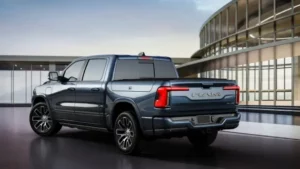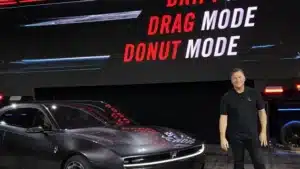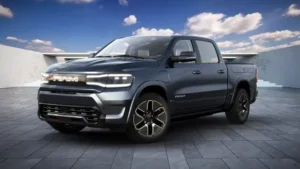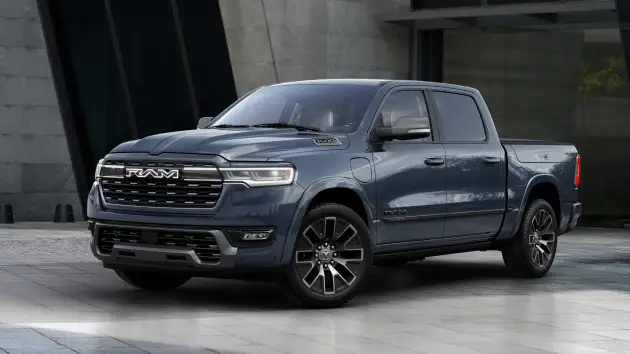Automaker Stellantis intends to build the Ram 1500 Ram charger, an electric pickup truck with a gas engine and an electric generator that will be the first of its kind in the industry.
In case that seems contradictory, here’s how it functions: When the truck’s battery runs out, an electric onboard generator powered by a 27-gallon, 3.6-liter V6 engine turns on to keep the vehicle running emissions-free.
According to Ram CEO Tim Kuniskis, the result is a truck that has the advantages of an EV, like quick acceleration and some zero-emission driving, without the range anxiety associated with most current electric vehicles.
This is the best solution available for battery-electric trucks. “It’s unlike anything else anyone has,” Kuniskis told reporters at a function. “This will completely change the landscape of battery-electric trucks.”
The 2025 Ram 1500 Ram charger and an all-electric Ram 1500 truck without a gas engine or a range-extending electric generator are anticipated to go on sale in late 2024.
According to Stellantis, the Ram charger has a range of up to 690 miles, of which 145 miles can be covered by a fully charged 92 kilowatt-hour battery when the extended-range power from the gas engine and 130 kilowatt electric generator is not used.
This range is comparable to the all-electric Ram 1500 REV pickup’s anticipated 500 miles of range. It also surpasses the current Ram 1500, which, according to the U.S. Environmental Protection Agency, has a 3.6-liter V-6 engine and a 26-gallon fuel tank with a maximum range of 546 miles.
The Ram charger’s price was not disclosed by Stellantis. It was unveiled on Tuesday along with a redesign of the current generation of gasoline-powered Ram 1500 pickups for the 2025 model year.
It’s not a PHEV.
According to Kuniskis, the Ram charger is designed to act as a link between conventional trucks with internal combustion engines and all-electric trucks, which presently encounter major challenges with regard to range anxiety and charging infrastructure, particularly when the vehicles are towing, which is the primary function of a truck.
According to Stephanie Brinley, associate director of Auto Intelligence for S&P Global Mobility, these enhancements might set the brand apart.
“It addresses the reality that the industry, and the pickup truck segment in particular, is not yet prepared to switch to electric vehicles fully,” the spokesperson stated. It’s a powerful solution that tackles some of those performance and range anxiety issues. However, the challenging aspect will be persuading customers of its capabilities.

Extended-range electric vehicles, or EREVs, are vehicles with a similar propulsion system that are sold in foreign markets, particularly in China. It has also been available in automobiles like the General Motors-canceled Chevrolet Volt sedan.
According to Stellantis engineers, the primary distinction between the Ram charger and Volt’s technologies is that, in the event that the battery runs out, the truck is only powered by electric motors rather than the car’s engine. Additionally, it is anticipated to be used for the first time in a full-size pickup truck in production.
According to Stellantis, the Ram charger has 663 horsepower and 615 foot-pounds of torque, and it can go from 0 to 60 miles per hour in 4.4 seconds. According to the company, the truck will be able to perform bidirectional charging, in which it will function as a generator to power appliances or even an entire house.
The head of Stellantis’ Dodge brand, Kuniskis, remained silent when asked if other cars would use the Ram charger’s technology. In the United States, Fiat, Jeep, and Chrysler are additional Stellantis brands.
The Ram charger functions in a different way than the current generation of plug-in hybrid electric cars, or PHEVs, which provide a range of all-electric driving until the battery runs out.

Kuniskis declared, “The Ram charger is not a PHEV.” “It’s a battery-electric truck with a high-speed charger built right in.”
“The engine and the wheels are not connected,” he declared. “The purpose of the gas generator is to only charge the battery.”
Ram employs a distinct truck strategy than that of its top rivals, Ford Motor and GM. While GM has stated that it intends to switch from traditional trucks to electric ones without the use of hybrids, the latter is offering traditional, hybrid, and all-electric versions of its F-150 full-size truck.
PHEV versions of the Chrysler Pacifica minivan, Jeep Wrangler, and Grand Cherokee SUVs are presently available from Stellantis.
Farewell, Hemi
The Ram charger’s design is a hybrid of the new gas-powered versions of the classic trucks, which will go on sale early in 2019, and the all-electric Ram 1500 REV.
The Ram charger has new badging that debuted on the all-electric truck, illuminated lines across its grille from the headlamps, and other design and facia elements between the two.
The most significant modification for the conventional Ram 1500 models is the company’s decision to discontinue the popular Hemi V-8. The truck’s current 5.7-liter Hemi engine will be swapped out for the Hurricane, an inline six-cylinder twin-turbo engine.

The fact that there won’t be a Hemi inside will annoy some customers, Kuniskis predicted. Indeed, the Hemi is a true legend. The Hemi is a beloved vehicle among Americans, but this thing simply beats it.
A high-output version of the 3.0-liter Hurricane engine is rated at 540 horsepower and 521 foot-pounds of torque, while the standard engine has 420 horsepower and 469 foot-pounds of torque. This is in contrast to the current V-8 Hemi, which has torque of 410 foot-pounds and 395 horsepower.
Although automakers like BMW and Jaguar have employed inline, or straight, six-cylinder engines in their vehicles, they are not very common in the country.
Other modifications to the trucks include the addition of a performance variant called RHO to replace Ram’s high-output TRX pickup, which is powered by a Hemi 6.2-liter V-8 engine producing 702 horsepower and 650 foot-pounds of torque, and a new luxury model called Tungsten.





